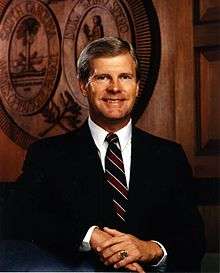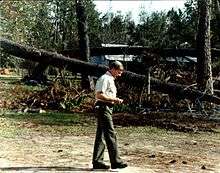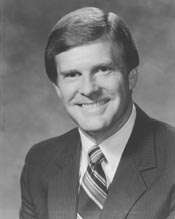Carroll A. Campbell Jr.
Carroll Ashmore Campbell Jr. (July 24, 1940 – December 7, 2005), was an American Republican Party politician who served as the 112th Governor of South Carolina from 1987 to 1995. Prior to this, he served as a member of the South Carolina Senate representing the 2nd district from 1977 to 1978 and as a congressman representing South Carolina's 4th district from 1979 to 1987.
Carroll Campbell | |
|---|---|
 | |
| 112th Governor of South Carolina | |
| In office January 14, 1987 – January 11, 1995 | |
| Lieutenant | Nick Theodore |
| Preceded by | Richard Riley |
| Succeeded by | David Beasley |
| Chair of the National Governors Association | |
| In office August 17, 1993 – July 19, 1994 | |
| Preceded by | Roy Romer |
| Succeeded by | Howard Dean |
| Member of the U.S. House of Representatives from South Carolina's 4th district | |
| In office January 3, 1979 – January 3, 1987 | |
| Preceded by | James Mann |
| Succeeded by | Liz J. Patterson |
| Member of the South Carolina Senate from the 2nd district | |
| In office January 11, 1977 – November 6, 1978 | |
| Preceded by | Richard Riley |
| Succeeded by | Jeff Richardson |
| Member of the South Carolina House of Representatives from Greenville County | |
| In office December 1970 – December 1974 | |
| Preceded by | Thomas Wesley Greene |
| Succeeded by | None (district eliminated) |
| Personal details | |
| Born | Carroll Ashmore Campbell Jr. July 24, 1940 Greenville, South Carolina, U.S. |
| Died | December 7, 2005 (aged 65) West Columbia, South Carolina, U.S. |
| Political party | Republican |
| Spouse(s) | |
| Children | Michael Campbell Carroll A. Campbell III |
| Education | University of South Carolina, Columbia American University (MA) |

Early life
He was born in Greenville, South Carolina, the oldest of six children. His father, Carroll A. Campbell Sr., worked in the textile mills and the furniture business, and later owned a motel in Garden City, South Carolina.
Campbell grew up in Greenville and the nearby cities of Liberty and Simpsonville. He attended Greenville Senior High School, dropping out during a period that The Greenville News characterized as an "unsettled adolescence amid a disintegrating family"; his uncle then enrolled him at the private McCallie School in Chattanooga, Tennessee. He attended the University of South Carolina at Columbia but withdrew because of financial concerns and later graduated with a Master of Arts degree from American University. While a student at South Carolina, he became a member of the Sigma chapter of the Pi Kappa Phi fraternity.
Early political career
In 1970, Campbell took a leading role opposing the racial integration of public schools in Greenville. He spoke to a crowd of thousands in front of Parker High School against integration, and on January 25 he led a motorcade of 800 vehicles to the state capitol to Columbia to protest "forced busing" of students to integrated schools.[1]
Campbell served in the South Carolina House of Representatives from 1970 to 1974 during the administration of Governor John C. West, who defeated Republican nominee Albert Watson, the choice of U.S. Senator Strom Thurmond, in the 1970 South Carolina gubernatorial election. With Lee Atwater as a key political strategist, he made an unsuccessful bid for lieutenant governor in 1974 on the ticket headed by Republican James B. Edwards of Charleston. While Edwards was elected, Campbell lost to the Democrat Brantley Harvey; despite the loss Campbell would continue to seek Atwater's counsel throughout his career.
From 1976 to 1978, during the Edwards administration, he served in the South Carolina Senate. In between his two stints in the General Assembly, he served as executive assistant to Governor Edwards. In 1978, Campbell won election to the United States House of Representatives from the Greenville-based South Carolina's 4th congressional district; he defeated Max Heller, the Democratic mayor of Greenville and an emigrant from Austria, to fill the seat vacated by the retiring James Mann.[2] Campbell hence became the first Republican to hold the 4th district seat since Reconstruction. Campbell served as state campaign chairman for Ronald Reagan's presidential campaign in 1980 and 1984, and as southern regional chairman for George H. W. Bush's presidential campaign in 1988.
Governor of South Carolina (1987–1995)

As governor, Campbell coordinated the state's response to Hurricane Hugo in 1989. Campbell was also known for his role in luring BMW to build its first U.S. manufacturing facility in Greer, South Carolina.[3] In recognition of his role, in 2002 it was announced that BMW had donated $10 million for a facility at the site of Clemson University's International Center for Automotive Research. Like nearly all such large donations, it came with naming rights: the company chose to call the new facility the Carroll A. Campbell Jr. Graduate Engineering Center.
When Campbell was governor, the state was confronted with two major controversies shaking taxpayers' confidence in the trustworthiness of public officials. Allegations of financial mismanagement at the University of South Carolina led to university president James B. Holderman's resignation. Operation Lost Trust, a federal investigation of bribery and drug use allegations against members of the South Carolina legislature, led to convictions of twenty-seven legislators, lobbyists and others in a vote-buying scandal.
During 1993–1994, Campbell was the chairman of the National Governors Association.
Term limits prevented him from seeking a third term in the 1994 election.[3] He left office with an unprecedented job approval rating of 72 percent.
Subsequent career
From 1995 to 2001, Campbell was a Washington, D.C. lobbyist, serving as president and CEO of the American Council of Life Insurers.[3] Campbell briefly considered running for U.S. President in 1996, but concluded that the fundraising hurdles were too high.
Following his decision not to run for president that year, Campbell was mentioned as a possible vice presidential running mate for Bob Dole but was ultimately passed over in favor of Jack Kemp, the former U.S. Representative from New York's 31st congressional district and later the United States Secretary of Housing and Urban Development under the first President Bush.
In 1998, Campbell and former South Carolina First Lady Lois Rhame West became the co-chairs of Winthrop University's first capital campaign. Under Campbell and West, the campaign raised more than $30 million.[4]
Personal life

Campbell eloped with Iris Faye Rhodes in 1959. They had two sons, Carroll Campbell III, and Mike Campbell, the former of whom unsuccessfully sought the 2010 Republican nomination for South Carolina's 1st congressional district to succeed Representative Henry Brown; and the latter of whom was an unsuccessful candidate for Lieutenant Governor of South Carolina in 2006. The family owns franchises for Wendy's restaurants in South Carolina.
In October 2001, aged 61, Campbell was diagnosed with Alzheimer's disease.[5] The revelation forced him to abandon plans to run for governor again in 2002. He was admitted to a long-term residential treatment facility for Alzheimer's patients in August 2005. He died of a heart attack on December 7, 2005, at Lexington Medical Center in West Columbia. After lying in state at the State House, he was eulogized at memorial services at Trinity Episcopal Cathedral in Columbia and at All Saints Episcopal Church in Pawleys Island.[6][7] He was buried in the church cemetery of All Saints Episcopal Church.
Upon Campbell's death, David Wilkins, U.S. Ambassador to Canada and former Speaker of the South Carolina House of Representatives, described him as "the master architect" of the South Carolina Republican Party's speedy rise to dominance.
Election history
- Carroll Campbell (Republican), 51%
- Michael R. Daniel (Democrat), 47%
- Carroll Campbell (Republican), 69%
- Theo Mitchell (Democrat), 27%
References
Notes
- "How Greenville County's public schools integrated peacefully in 1970". Judith Bainbridge. Greenville News. November 2, 2019. Retrieved November 3, 2019.
- Graham, Cole Blease (Spring 1998). "Between a Rock and a Hard Place: South Carolina's Republican Presidential Primary". Southern Cultures. 4 (1): 48. doi:10.1353/scu.1998.0091. JSTOR 26235530.
- "Carroll A. Campbell". National Governors Association. Retrieved April 2, 2020.
- O'Mara, Dan (May 6, 2014). "Winthrop alum Lois Rhame West, former SC first lady and 'bright light', dies". The Herald (Rock Hill). Archived from the original on July 14, 2014. Retrieved July 13, 2014.
- Campbell, Carroll (October 5, 2001). "Letter from Carroll Campbell". The State. Retrieved April 2, 2020.
- O'Connor, John (December 9, 2005). "Public Can Pay Respects Today". The State. Retrieved April 2, 2020.
- "South Carolina Governor Carroll Campbell Funeral | C-SPAN.org". www.c-span.org. Retrieved April 2, 2020.
Sources
- ^ "Former Gov. Carroll Campbell dead at 65". Archived from the original on September 1, 2006. Retrieved September 1, 2006.
- ^ The Once and Future King?, from a June 2000 column in National Review
- ^ The Carroll A. Campbell Jr. Graduate Engineering Center at Clemson University
- ^ Nomination of Carroll A. Campbell Jr., To Be a Member of the Board of Trustees of the James Madison Memorial Fellowship Foundation at the Wayback Machine (archived November 14, 2004)
External links and general sources
- Carroll Campbell Bio, Education, Occupations, Timeline of Major Events and Accomplishments, Election Results, SCIway.net; accessed August 4, 2017.
- Biography from the Biographical Directory of the United States Congress; accessed August 4, 2017.
- Former S.C. governor has Alzheimer's, an October 2001 USA Today article; accessed August 4, 2017.
- "It's been a really bad day". Archived from the original on March 10, 2007. Retrieved December 8, 2005., a December 7, 2005 blog entry from Campbell's former Chief of Staff
- Biography of Carroll A. Campbell Jr., National Governors Association website; accessed August 4, 2017.
- Appearances on C-SPAN
- Carroll Ashmore Campbell, Jr. Papers at South Carolina Political Collections (University of South Carolina)
- Carroll Campbell Papers (Mss. 0087) at Clemson University
- Governor Carroll A. Campbell, Jr. Papers (RG 555000) at the South Carolina Department of Archives and History
| Party political offices | ||
|---|---|---|
| Preceded by James M. Henderson |
Republican nominee for Lieutenant Governor of South Carolina 1974 |
Succeeded by John Stroud |
| Preceded by W. D. Workman |
Republican nominee for Governor of South Carolina 1986, 1990 |
Succeeded by David Beasley |
| Preceded by John Ashcroft |
Chair of the Republican Governors Association 1990–1991 |
Succeeded by Tommy Thompson |
| U.S. House of Representatives | ||
| Preceded by James Mann |
Member of the U.S. House of Representatives from South Carolina's 4th congressional district 1979–1987 |
Succeeded by Liz J. Patterson |
| Political offices | ||
| Preceded by Richard Riley |
Governor of South Carolina 1987–1995 |
Succeeded by David Beasley |
| Preceded by Roy Romer |
Chair of the National Governors Association 1993–1994 |
Succeeded by Howard Dean |
